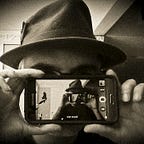Q & A with Ramon Cruz
This project continues to amaze me. The mere fact that these amazing photographers take the time to answer my questions and answer my emails is just mind blowing for me.
The work of Ramon Cruz is just mind blowing. When I think of quintessential street photography I envision his work. Every single one of his photographs tells a story and creates its own universe.
A photographer must be psychic. He must know what he is subject is thinking and feeling and somehow translate that into a photograph. Ramon Cruz has super hero level psychic powers.
Ramón Cruz is a college professor and photographer based in Chihuahua, México. Documentary, portraiture and street photography are his areas of focus. He has a degree in Psychology and a master’s degree in Communications. His work has been exhibited in Brussels, Istanbul, Italy, India and México. He is currently a member of 1415 Mobilephotographers and Co-founder of Norte Sur Collective.
Ramon´s work has been published in Only Mobile Art, Better Photography and the BOW Collection of 14&15 Mobile Photographers. And his documentary portfolio has been nominated in the Hipstography Awards.
LINKS:
Instagram: @ramoncruz3
Twitter: @rcruzg3
Mail: head73@gmail.com
Page: https://www.1415mobilephotographers.com/ramon-cruz
1) Why do you use a cellphone in your work? What does it allow you to do that a traditional camera does not?
It is much more comfortable, also allows you to get closer and go unnoticed easier. Now everyone has a mobile in their hands. For example, I do not usually check after taking a picture, but if it did, it´s possible to edit anywhere as opposed to the traditional process.
2) How is mobile photography different from traditional photography? is it a different art form?
I think that only the instrument and the tools are the ones that change. What really matters is what you want to express in each image, know your visual speech.
3) What do you wish your cellphone could do that it currently cannot?
Maybe include an external flash to experiment with night shots without sacrificing the quality of the images. Something like Daido Moriyama. If there is, I do not know, but I think it would be fun.
4) What do you see as the future of mobile photography?
It´s the result of an evolution in the process of the image. I see it adapting more and more. Now the mobiles are waterproof, more capacity, more intuitive, more resistant to breaking, etc. And that seems great to me, this will facilitate your intervention in the digital narrative. Now it´s possible print your own photo book from your cellphone. it’s literal, from the palm of our hands!
5) What should people read / view / listen to to better understand mobile photography?
To read I recommend reviewing works published by Joan Fontcuberta, Carlos Scolari, Jacob Bañuelos, Óscar Colorado and Richard Koci Hernández. Who have written and talked about photography 3.0, transmedia narratives, the concept of appropriation, the post-photography and photographic hybridization and other topics. These authors make an analysis in the process and conceptualization of the digital image that helps to understand the digital narratives in the new media. To view, there are groups that have been doing interesting projects exclusive with mobile, such as Tiny Collective, Hikari Creative and 14&15 Mobile Photographers.
6) What topic would you like me to investigate more in terms of mobile photography?
The narrative and the methodology of the authors. Know how they think about their projects, creative processes, platforms they use, etc.
7) Who are your major influences / who do you follow in terms of mobile photography?
Influences (the classics): Nacho López, Bernard Plossu, Lola Álvarez Bravo, Graciela Iturbide, Harry Callahan and many others. Now in terms of mobile photography: Richard Koci Hernández, David Ingraham, Elif Gulen, Sevil Alkan, Q. Sakamaki and Eric Mencher. In this combination of references I found my inspiration to work the light, shadows, process of the images, view the ordinary with another look and built my proposal every day and everywhere.
8) What are your favorite Apps?
I used Hipstamatic (with personal combos) but in mode classic, Snapseed for process some details and occasionally VSCO for colour. I explore others, but this are my basic apps to process my work in the iPhone 8 Plus.
